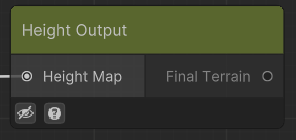
Permanent node that exists in both Biome and World generators. It defines the final form of the world by the input. This Height Map should contain the data that representes the world height in world units.
Inside Biome graphs, it will also include an optional output field, Final Terrain. This output node will give the final resulting terrain of the whole world. It’s useful for those cases where, because of blending, the features extracted from the biome terrain (via Get Cavity or Get Slope) do not align with the final terrain.
For those cases, it is recommended to connect all feature extraction nodes to Final Terrain.
Examples
Feature Extraction
Notes
We start by creating the terrain using a simple Perlin Noise with a few octaves.
Next, we connect it to the Height Output to ensure the data will be used, and then extract features using the Get Slope and Get Cavity nodes. We use the data generated by these nodes to select specific regions—such as areas with high slope or regions where the terrain is relatively flat—and paint them using the Color Output.
Finally, using the Fold node, we transform the flat region mask into a selection of all concave and convex areas.

Node system

Result
Desert Pyramids
Recipe
Notes
To place different pyramid-like structures, we start by creating a grid of points and randomly positioning them. We use the Jitter Points Node to randomize their position, rotation, and scale.
At each of these points, we create a pyramid using the Shape Node and spawn it with the Points To Height Node. By ticking the required boxes, we ensure that the sampled shape follows the points data correctly.
Next, we apply some stepping to the pyramids to add texture, making them look more like layered cubes.
We then combine the pyramids with basic noise to give them a less uniform look, as though there’s sand on top of each layer.
Finally, we blend these pyramids with some Simplex Noise to achieve the final terrain.

Node system

Result